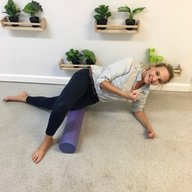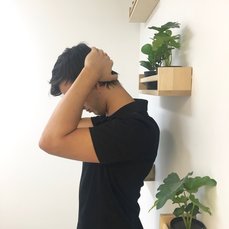- Avoid Injury and Improve Performance through Stretching, Rolling and Self Massage -
Improving your flexibility through triggering, self massage techniques such as triggering and foam rolling is extremely important for cycling.
- How Does it Work?-
Help your body 'out of the cycling position!'
Due to the nature of cycling (sitting in the saddle for hours on end) significant amounts of stress is place on the body. The body is not meant to stay in one position for extended periods of time. It's important to help the body out of the cycling positions to avoid injury and discomfort. It's important to ensuring you are stretching your body the opposite way to the cycling position - for example using the foam roller on your thoracic spine to extend you backwards after hours bending forwards is really important. The other key exercise for this is to lengthen out through your hips by loosening off your quads and hip flexors through self massage like triggering and stretching. This helps you avoid lower back pain.
Improve Performance
Firstly avoiding injury is a sure way to improve performance! The reason being if you need to take a week or two off because of injury you are immediately at a disadvantage compared to the cyclist who's looked after themselves and managed to train through. Consistency is everything on the bike so doing what ever you can to ensure you complete the k's is important! Knee Pain and Lower Back Pain are the two cycling related injures that we see most often. Loosening through your lower back, hip flexors, gluts and quads is important to address these two concerns.
Avoid Discomfort on the Bike
Who hasn't sat on the bike for extended periods of time and gotten a sore neck? Have you jumped off the bike after a long ride and winced as you stand up properly for the first time in a few hours!? Yet what are you dong about it? A mid-ride stretch in a coffee break for a long ride may look a little funny but if it's the difference between lasting the whole way back and being dropped we know what we would choose! For neck tightness - doing a few neck stretches (lev scap & traps - see below) are two simple stretches that can keep you comfortable on the bike. For your hip flexors - performing a 'heel to butt stretch' that loosened through your quads and TFL can help with tightness around your knees and lower back pain. (And doesn't look quite as strange as getting into a full hip flexor stretch like the 'Psoas stretch' below.
How long do I hold my stretches and triggers for?
- Stretching - A minimum of 1:30mins per muscle group
- Foam Rolling & Self Massage Techniques like Triggering - A minimum of 1;30mins per muscle group and when you feel a change (decrease in pain) if you feel numbness, pins and needles or electric pain roll off that spot! You could be on a nerve/ vein/ artery! You are looking for a deep ache with referral.
- That's alot of stretching/ foam rolling and triggering down below! What are the priorities? -
Technically the list below would take you 39 minutes to get through. So if you divided it into 2 x 20mins blocks you could get through the entire list in a week! You don't need to do every stretch, every time.
Picking what to priorities is going to depend entirely on each individual and if you you would like a tailored program have a chat to your remedial massage therapist/ myotherapist. However below the photos we have provided a guide or how to prioritise.
- A Manageable Guide to Improving Flexibility and Avoiding Injury for Cycling -
Prioritise:
So why have you listed so many other stretches/ triggers below?
As you know there are a lot of additional areas of the body that get tight from cycling. Gripping the handles tightens through your forearms, doing alot of hill work not only tightens through your legs but loads up through your shoulders particularly your lats. Your lats (the muscles on the side of your bod) play a role in lower back pain and upper body posture. So loosening them off is important. Your calves get extremely tight when cycling and having good range of motion through your ankles can help with performance.
- Psoas Stretch, Quad Foam Rolling and Glut Triggering for avoiding Lower Back Pain & Knee Pain first.
- Thoracic Extension on the Foam Roller - to avoid lower back pain and that typical 'cyclist's hunch back' which can contribute to neck and shoulder pain.
- ITB Foam Rolling & TFL to avoid knee pain
- Pec Triggers & Neck Stretches - Holding onto the bike handles uses your pecs and in return these can contribute to poor upper body posture and the old 'cyclists hump!' Cycling head posture can cause neck tightness which can contribute to headaches.
- An easy way to get through all these stretches in a week would be the following: (We've recommended Psoas Stretch twice as it's really important!
- Day 1: (9mins) Psoas Stretch, Quads Foam Rolling Glut Triggering
- Day 2: (9mins) Psoas Stretch, Thoracic Extension, ITB Foam Rolling/ TFL Tiggering
- Day 3: (9mins) Pec Tiggers, Traps Stretch, Lev Scap Stretch
- Day 4: (20mins) - Pick a few of the others on the list and work through them.
So why have you listed so many other stretches/ triggers below?
As you know there are a lot of additional areas of the body that get tight from cycling. Gripping the handles tightens through your forearms, doing alot of hill work not only tightens through your legs but loads up through your shoulders particularly your lats. Your lats (the muscles on the side of your bod) play a role in lower back pain and upper body posture. So loosening them off is important. Your calves get extremely tight when cycling and having good range of motion through your ankles can help with performance.

Latissimus Dorsi Stretch
Hold for 1 - 1:30mins leaning further and further away.
- Standing in a door way/ in front of a pole.
- Grab on to the structure, with one arm above your head.
- Draw the body and hips away until you feel a stretch in the side of your body and shoulder.
Hold for 1 - 1:30mins leaning further and further away.











